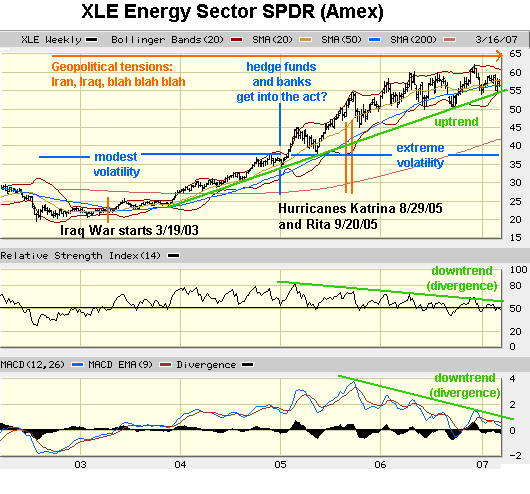

|
| weblog/wEssays archives | home | |
|
The Financialization of Oil (March 20, 2007) BusinessWeek ran a short but critically important interview back in January which I excerpt below on the Financialization of Energy Markets. What this means is a stupendous proliferation of trading financial instruments (derivatives and futures) which are based on the actual commodities (oil and natural gas). There has long been a futures market for oil, but now that the large investment banks and hedge funds have "financialized" the market, there are trillions in derivatives being written which carry vast amounts of risk. As Mr. Fusaro explains below, this financialization is just in the first inning. The current energy derivative market which he pegs at $3 trillion could expand up to an $80 trillion market--20 times the market for physical oil and gas. One energy-trading hedge fund blew up a few months ago, losing $6 billion in a matter of days. This kind of speculative trading is now heavily influencing the price movements of oil. To illustrate this, I've marked up a chart of a major energy ETF (XLE). Note that there have only been two crises which had the potential to affect markets: the Iraq War starting in early 2003 and Hurricanes Katrina and Rita in late 2005. The rest of the time, there was a background noise of "geopolitical tensions." Note how oil moved up with modest volatility until 2005, at which point wild swings in price became the norm. Yet other than the hurricanes--which affected perhaps 2% of global oil production--there were no events in the physical world to explain or trigger such wide swings in price. 
Here are some excerpts from the interview: A Fast New Financial Game Called Energy: Energy consultant Peter C. Fusaro, chairman of New York-based Global Change Associates Inc. and co-founder of the Energy Hedge Fund Center, was among the first to notice the growing role of hedge funds and other financial players in the energy sector two years ago. He talked to Washington correspondent Lorraine Woellert about how the trend is contributing to price fluctuations and where it's going next.I also drew some green lines on the chart to show the long-term uptrend in price, and the diverging downtrends in MACD and RSI. This should give us pause about the sustainability of the uptrend. Beneath all the price swings in the chart lies the issue of Peak Oil. Production is peaking, creating the inevitability that supply will not meet demand in the near future, causing massive price increases. Analyst/contributor U. Doran has supplied a number of in-depth stories on the decline in both Saudi and Mexican super-giant oil fields. I recommend all these links. The BusinessWeek story accompanied the above interview; the rest of the links are courtesy of U. Doran: Barrels Of Confusion: Where crude prices go next is anybody's guess, so companies are learning to live with volatility--and Wall Street is cleaning up (BusinessWeek) Association for the Study of Peak Oil & Gas-USA--list of papers from Oct. 06 Sample ASPO-USA presentation--the Hubbert Awards for 2006 Author Matt Simmons presentation-- Is The World’s Energy Supply Sustainable? (www.simmonsco.com) Best summary of global energy realities I've ever seen in only 40 slides Low Oil Inventories Ease Opec’s Job and Add Further Upside Oil Price Risk (UBS Investment Research) A Nosedive Toward the Desert (saudi oil production decline) (www.theoildrum.com) Saudi Arabian oil declines 8% in 2006 (www.theoildrum.com) Pemex celebrates 69th anniversary, but problems loom Depleted reserves, crumbling pipelines, outdated technology and billions of dollars in debt.... (Houston Chronicle) Peak Oil Update--February 2007 (www.theoildrum.com) For more on this subject and a wide array of other topics, please visit my weblog. copyright © 2007 Charles Hugh Smith. All rights reserved in all media. I would be honored if you linked this wEssay to your site, or printed a copy for your own use. |
||
| weblog/wEssays | home |